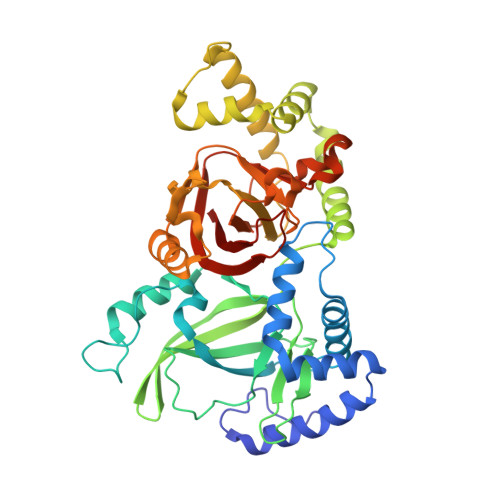Crystal structure of the ADP-ribosylating component of BEC, the binary enterotoxin of Clostridium perfringens.
Kawahara, K., Yonogi, S., Munetomo, R., Oki, H., Yoshida, T., Kumeda, Y., Matsuda, S., Kodama, T., Ohkubo, T., Iida, T., Nakamura, S.(2016) Biochem Biophys Res Commun 480: 261-267
- PubMed: 27751850
- DOI: https://doi.org/10.1016/j.bbrc.2016.10.042
- Primary Citation of Related Structures:
5H03, 5H04 - PubMed Abstract:
Binary enterotoxin of Clostridium perfringens (BEC), consisting of the components BECa and BECb, was recently identified as a novel enterotoxin produced by C. perfringens that causes acute gastroenteritis in humans. Although the detailed mechanism of cell intoxication by BEC remains to be defined, BECa shows both NAD + -glycohydrolase and actin ADP-ribosyltransferase activities in the presence of NAD + . In this study, we determined the first crystal structure of BECa in its apo-state and in complex with NADH. The structure of BECa shows striking resemblance with other binary actin ADP-ribosylating toxins (ADPRTs), especially in terms of its overall protein fold and mechanisms of substrate recognition. We present a detailed picture of interactions between BECa and NADH, including bound water molecules located near the C1'-N glycosidic bond of NADH and the catalytically important ADP-ribosylating turn-turn (ARTT) loop. We observed that the conformational rearrangement of the ARTT loop, possibly triggered by a conformational change involving a conserved tyrosine residue coupled with substrate binding, plays a crucial role in catalysis by properly positioning a catalytic glutamate residue in the E-X-E motif of the ARTT loop in contact with the nucleophile. Our results for BECa provide insight into the common catalytic mechanism of the family of binary actin ADPRTs.
Organizational Affiliation:
Graduate School of Pharmaceutical Sciences, Osaka University, Suita, Osaka, Japan.














